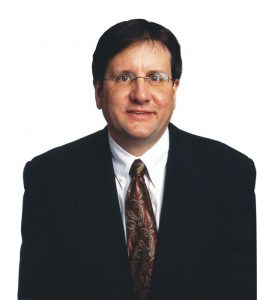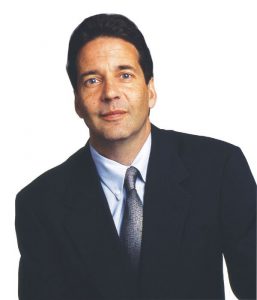Infrastructure—the human footprint on the planet, the processes, systems, instrumentalities and built environment we inhabit—makes our lives possible. It provides the foundation for the lives we hope to live in the near and distant future. Modern infrastructure is the global tendrils of humanity, reaching all corners of the globe and binding us together in our local communities and globally. Providing infrastructure for a growing world populace and meeting the needs of new generations that demand smarter and more sustainable infrastructure are continuing challenges.
Presently, the sheer scale of infrastructure development is mind-boggling. While it may not be as pronounced in our local communities as in other locales, take a look online in Google Street View at different places around the globe to see many examples of staggering growth in infrastructure. The term “developing countries” now has a new definition, incorporating both tremendous growth in population and urbanization that’s spurred by the growth of individual wealth.
While many developed nations see a modest 2% growth in individual wealth, some countries, like India, have seen as much as 10% growth. Infrastructure is booming to meet these dual demands. Even developed economies are seeing surges in development from the recent decade of economic recovery, a generational population surge, and the need to address aging infrastructure born of past economic booms.
Yes, there is a global infrastructure boom currently underway, and Bentley Systems, an engineering design software company, has become inexorably joined at the hip with the rise of modern infrastructure design and development. This symbiosis was rooted in the earliest days of the company’s inception, more than 34 years ago (see “The Bentley Brothers,” below).
But now that global infrastructure development has gone into hyperdrive, the world of Bentley is touching so many other facets, such as reality capture, BIM methodology, monitoring and operations, and new forms of integration between disciplines that had traditionally been somewhat compartmentalized, like bridging legacy barriers between engineering, surveying, construction, and more.
Bentley’s Year in Infrastructure 2017 Conference (YII2017), held in Singapore, was the largest annual YII event to date. A key feature of the event is the presentation of the Be Inspired Awards for excellence in infrastructure, presented annually and honoring more than 2,500 outstanding nominees since the inaugural awards in 2004. This awards ceremony is unique in the world of infrastructure and AEC because of the broad range of categories represented, the global nature of the competition, and independent peer-selection panels.
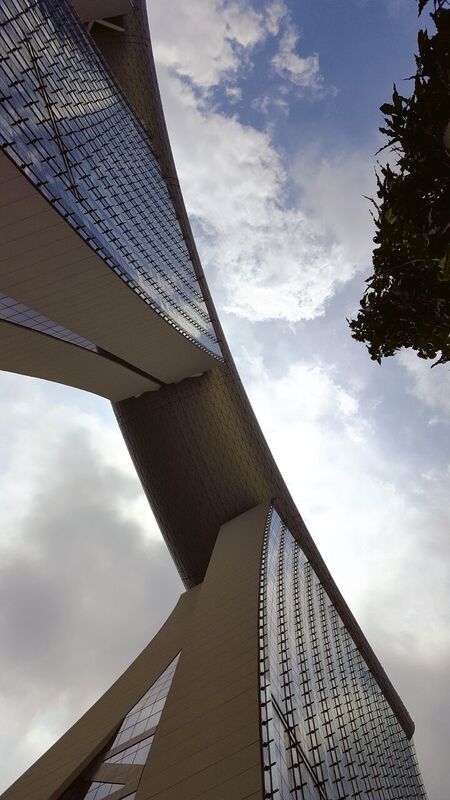
The iconic Marina Bay Sands hotel, expo, and conference centre (above, and featured image) in Singapore was the venue for the Bentley Year in Infrastructure 2017 conference and Be Inspired awards ceremony. This internationally lauded example of engineering, art, and design was a Be Inspired award-winner in 2010.
It is fitting that the Marina Bay Sands expo and convention center in Singapore was the venue for the Year in Infrastructure 2017 Conference and awards event as the building is an iconic example of engineering, art, and design excellence and was a Be Inspired award-winner in 2010. The annual conference has been held at various international venues, including Amsterdam in 2012, London in 2016, and Singapore in 2017.
YII2017 keynote speakers, including Bentley CEO Greg Bentley and Bentley alliance partner Siemens’ global head of information technology Helmuth Ludwig, noted an additional significance in choice of Singapore as the venue, characterizing the region as the “center of gravity” globally for advances in infrastructure and adoption of digital applications in BIM technology. (Read about the 2017 Be Inspired winners.)
Many readers may know of (or are already using) the newer generations of Bentley products. Rather than go through all of Bentley’s product offerings, which can be viewed on the Bentley website, we’re concentrating on the three current elements of Bentley Systems’ ongoing story that we feel are significant:
- growing technology partnerships;
- erasing legacy gaps among engineering, surveying, and construction; and
- innovation in the distribution and synchronization of engineering design models.
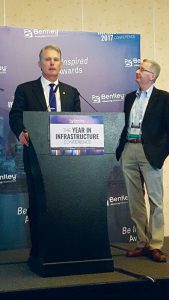
At the 2017 Year in Infrastructure conference, Topcon Positioning Systems CEO Ray O’Connor (left), and Bentley CEO Greg Bentley (right) announced the joint initiative of Constructioneering Academies, to begin in early 2018.
NOT Going It Alone
It seemed that the trend over the past two decades for geospatial-giant firms was to grow through acquisitions and seek to resolve infrastructure-lifecycle issues by producing all of the hardware and software. Approaches to managing lifecycles and solution integration have changed, with key hardware elements becoming more commoditized.
Conventional wisdom now holds that the production of tightly coupled, high-precision hardware and its companion operational software might be best left to experts in those fields and that engineering design software solutions are best left to Bentley, Autodesk, and other design software firms. What we see now (and several of our feature stories have examined prime examples of this) are more and more technology partnerships and joint development initiatives. These initiatives include partnerships among the positioning hardware/software, design software, and information technology firms. These partnerships are more common and successful now than they have ever been.
At Bentley’s Year in Infrastructure conference 2017, held in Singapore (the city-state is often described as the global “center of gravity” for infrastructure development and innovation), several key technology partnerships were highlighted, including:
Siemens is a global leader in providing sensors and system for many industries. Siemens and Bentley announced a strategic alliance in 2016 and have since announced further collaboration with the Siemens energy management division to jointly develop solutions to accelerate “going digital” for energy providers.
Microsoft: The two companies have collaborated in cloud-enabling Bentley solutions. For example, Bentley announced ProjectWise 365 Services, leveraging Microsoft Azure (cloud services) with a project dashboard in the Office 365 environment.
Bureau Veritas is a global leader in testing, inspection, and certification (TIC). New solutions will be developed for transportation and industrial infrastructure owners with Bentley’s expertise in data modeling and Bureau Veritas’ expertise in TIC for asset management.
Topcon Positioning Systems: Announced in 2016, Bentley and Topcon have launched a joint initiative under the term, “Constructioneering” (read xyHt‘s March 2017 constructioneering feature).
Bentley has participated in collaborative relationships with many industry-leading firms during its history; these four current alliances seek to enable the “going digital” campaign of digitizing infrastructure design, construction, inspection, and operations, perfecting BIM technology throughout a project’s entire lifecycle. Bentley could have attempted to do this all on its own but has instead recognized when to tap the expertise and resources of other leading firms.
Constructioneering
The initial thrust of the strategic alliance with Topcon Positioning Systems is to remove the barriers to smooth data flow among engineering, surveying, design, construction, and machine-controlled equipment. “Conceptioneering” and “inspectioneering” are additional terms similar to constructioneering, with similar goals in going digital and extending engineering approaches and accountability in respective fields.
The term “constructioneering,” in this context, was reputedly coined by CEO Greg Bentley in discussions with Topcon Positioning Systems president and CEO Ray O’Connor. They spoke about this alliance in a joint keynote at the YII2017 conference, where they also announced the development “Constructioneering Academies,” coming in early 2018.
“How do we solve this massive problem of automating the construction industry?” asks O’Connor. “I started as a young Irish immigrant boy in 1983 working on construction jobs and could not understand why we were not automated. At Topcon, we started working on that, and the first place we started was automating big equipment. Those machines work much in the same ways as milling machines, like in machine shops, and as I see them operate, we are simply machining the face of the earth.”
O’Connor asks, as he has before, “Why can’t the same level of automation that exists in factories and machine shops be achieved in construction?”
O’Connor speaks to the challenges that constructioneering seeks to address:
“As we grew that business, and as the business evolved, the question became, ‘How can we connect the engineers with the operations that are going on at the construction site?’ How do you make the software integrate seamlessly with the type of 3D models needed to drive the machine control systems and take that data and feed it back into the [engineering] systems?
“We are on a mission to automate the largest manufacturing industry in the world,” O’Connor continued, discussing the construction industry and noting that it is a US$10-trillion-a-year industry. “It is very difficult and has been a challenge to get to where we are today with big equipment automation. It took years, but automation will drive the industry in the future.”
Looking back at Topcon’s history, O’Connor mentioned that they create many different kits and instruments to automate a jobsite.
But, says O’Connor, “When somebody buys two new machines that are automated, then what about the other 100 machines? What about connecting all of them via Sitelink 3D for the communications to bring the data back and make them into IoT machines? We are on a mission to get that done, to continue to solve those problems so that you have a greater return on investments.”
O’Connor says that it takes more than just updating the hardware.
“If you do not solve the workflow issue, you do not have a solution. You have to think about the manufacturing industry; it is very fine-tuned, but those technologies, methods, and processes can be transitioned into our industry.”
Greg Bentley describes how the new, jointly developed constructioneering process works and how it will move the industry closer to the automation goal first by describing the legacy scenario of compartmentalization. “Engineering, survey, and construction is a continuous process, and it is rare that [data] is not simply handed from one group to another.”
Bentley discusses how constructioneering is now possible as, for instance, Topcon aerial vehicles and software can capture images of the construction site, and the data is then brought into Bentley ContextCapture, an engineering-ready reality environment, through Topcon MAGNET Enterprise cloud service.
Engineers are able to use this information in other applications, such as OpenRoads or OpenRail. This flow works both ways.
“The design can [go] back through MAGNET Enterprise from our connected design environment, federated with theirs, to the machine-control equipment using Topcon devices for accomplishment of heavy civil construction,” Bentley explains. “And then back again from positioning devices, capturing a record of what was actually built, into the engineering and management environment.”
Much of the hardware side of the equation is already in place, explains O’Connor.
“There is not one major [construction equipment] manufacturer not already integrating [machine control] systems into their machinesÑexponential growth in that area.”
The cost of adding [automation components] to machines used to be up to $100,000, according to O’Connor, but the development of sensors, systems, and actuators for autonomous vehicles is dropping costs for a lot of components.
Automation hardware is becoming standard on construction equipment; the pieces are in place, but, O’Connor warns, “If the engineering and construction sides do not calibrate, the workflow will not be solved.”
Advances in machine learning will only improve productivity.
“Machine learning for construction won’t just mean controlling the depth of a grader blade or positioning a bucket; it means the machine will provide feedback in real time, and learn from it, shortening [task] cycles,” O’Connor says.
The two companies have begun the constructioneering initiative by opening up elements of their respective software, but the work has also begun exploring the possibilities of implementing machine learning.
“A research project this summer mounted cameras on the blades and buckets of excavators that were doing trenching for subsurface utilities, because it is not possible to know and remember the 3D configuration of what is going on in the trench,” Bentley says.
Cameras and other sensors will be able to provide precise real-time feedback.
The next question to answer through machine learning involves how to use the imagery and how to classify the surveyed mesh. According to Bentley, Microsoft and Topcon are investing a lot in machine learning.
Machine learning may be on a near horizon, but these technology partners are currently helping their customers implement constructioneering.
“The initiative for us is to bring construction and engineering customers in from all over the world—U.S., Asia, Australia, Europe, Africa—and teach them how to get the most out of the systems that they buy from us today. Whether it is surveying, or UAV, or machine control, or the engineering design software,” O’Connor said.
Constructioneering Academies
At the YII2017, the two CEOs jointly announced the launch of Constructioneering Academies. What will these look like? Presently, the key points of collaboration are in the software and data-sharing mechanisms, so there will be classroom time and online-learning resources.
To provide full context, some of the Academy locations will be co-located at or near existing heavy civil construction training or actual construction sites, with real heavy equipment and earth to move. Topcon has often held their technology Road Shows at such venues. The first Constructioneering Academy locations and agendas for 2018 will be announced soon (check for notices at constructioneering.com).
Synchronizing Design Models
The next development could turn out to be quite significant. Synchronizing design models in the manner that Bentley has recently implemented challenges conventional wisdom on how to handle version-control and how project collaboration can be enhanced by the cloud, and it presents a new model (no pun intended) for how engineering and construction can accelerate “going digital” for infrastructure projects.
What is a Bentley iModel? Think of a portable design model: it is a database of everything you need to convey to stakeholders, implementers of BIM technology at constructions sites, collaborating engineers, and others within the workflow. Some liken iModels to portable document formats (e.g. PDFs), but, unlike some of those formats, it does not “pound the data flat” to genericize them.
iModels, first introduced in 2009, store graphics from simple 2D planimetry to complex 3D solids, standard data tables used in BIM software, and much more. Viewers and collaborators do not necessarily need the specific applications that created the data stored in the iModel to access it.
But each legacy iModel was a snapshot, and if any of the collaborators made changes, new copies had to be distributed. How many different versions of a design file do you have on your hard drive? Version control has bedeviled computer-aided design and drafting from day one.
Keith Bentley, executive vice president at Bentley Systems, wanted to remedy this challenge and provide additional capabilities to iModels where the cloud would feature prominently
There are some misconceptions about how “the cloud” can solve version-control issues. One misconception is the idea that there could be one giant master design loaded up into the cloud and that everyone involved can simply connect as thin clients and work collaboratively on the master. This idea would be a recipe for disaster and pose single points of potential failure.
For scalability and portability, having many individual copies of models is optimal— provided there is a way to keep them all synchronized, according to Keith.
“We have to embrace change—literally—and that change, the transactions and the timeline of changes, is what is most practical and valuable to enable in the cloud,” Keith says. iModels is the Bentley product that enables that, and the next evolution of the application is iModel 2.0, which is both a cloud platform (with the iModel Hub service) and a relational database.
“Think about your bank account. You do not get your whole account sent to you, only the monthly transactions,” Keith explains. “For the iModel, we need a ledger, a timeline that multiple users synchronize to, even if they have been working on their copy on a tablet in the field offline and then sync changes when connected, adding their updates and receiving updates from others.”
I ask Keith if this type of collaboration model is being used in other industries, and he mentions GitHUB, a popular (and rapidly becoming the standard) for software developers, for commercial and especially open-source code development. GitHUB has an online version-control repository hosting service that makes it possible for dozens of developers from all over the world to collaborate on programming code, to work on their own sections of code, and to sync with the rest. Each developer can work on their own copy, and through processes like “nightly builds,” they can all update reflecting everyone’s changes or select the changes relevant to their own work.
“People ask, ‘Where is the master [copy]?'” says Keith. “There is no master; the ledger [of changes] and the timeline is the master, and this is on the cloud service.”
This is a similar model to what Keith and his team have developed for iModel 2.0. Changes are noted graphically and in tabular data in a familiar color schema: red for deletions, green for new additions, and blue for altered. Users can sync up to the iModel Hub and update all, or just the relevant parts, of their own iModel.
Keith explains that another goal for iModel 2.0 is to reduce “dark data” on hard drives and offer better data alignment. There are files that are perfectly valid, as they apply to the applications that originally created them or use them natively, but there is also dark data because you have many versions of data and in many formats.
“How do you go to iModel 2.0 without having to start from scratch?” asks Keith. “We have iModel bridges for different applications. This can help you transition from dark data on your computer to automated cloud services.”
Better-aligning data means how well it’s defined in the model, and to standards, so that as many applications as possible can read, recognize, and utilize the information. Keith notes, “Data alignment and realignment will be the key to success in machine learning and cloud services.”
Your Role
With the blurring of traditional roles in geospatial professions and industries and the forging of new roles, business opportunities, and career pathsÑmany that did not exist only a few short years ago—the interconnected world of modern infrastructure is the nexus.
This treatise on Bentley is an example of what’s going on in the world of infrastructure and where it’s headed. There’s a lot of exciting innovation and development to support infrastructure development by many other firms, and we will publish about those, as well. This example is particularly pronounced, and the subject firm and their global community of users is focused in their self-association with infrastructure.
Whether you are a direct user, an indirect user, or working with unrelated solutions, you are part of the ongoing process of accelerating the “going digital” of infrastructure development. If you have an opportunity, try to attend a Year in Infrastructure conference or a similar event; you will most definitely be impressed and, we hope, inspired.
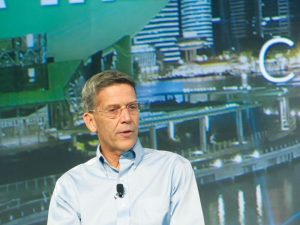
Founder Keith Bentley is working on solutions leveraging what he considers the next “once-in-a-lifetime” opportunity: the cloud and machine learning.
The Brothers Bentley
When asked about the early days of Bentley Systems, founder and CTO Keith Bentley likes to tell the following anecdote. “I remember 35 years ago hearing a guy named Bill Gates from a little company called Microsoft talking about how the personal computer was going to revolutionize individual productivity.
“And I remember sitting there thinking, You know what? That guy is right. And I thought to myself, Hey, this is a once-in-a-lifetime opportunity, and I’m all in.“
He did, of course, go all in, and the results out-shined initial expectations. We’ll revisit Keith’s story and update in a future issue, but first we look at what Keith and his brothers did in those pivotal years and how we may soon be seeing a repeat of history.
Keith Bentley was working as an engineer at DuPont in the early 1980s, using the large mainframe-based CAD system from Intergraph. Such systems represented the state of the art in computer-aided design and drafting, but per-seat costs were high.
(On a side note: I was using the same type of system at the time and remember that you often needed a large, dedicated, climate-controlled computer room, and the workstations were mostly massive dual screen units, sometimes with table-sized digitization surfaces and multi-button pucks. Occasionally, a peripheral terminal was connected (e.g. VT 100) for data entry. Per-seat costs were substantial.)
Keith came upon the idea to write software to run on a small CRT terminal (and later a PC) to perform many of the same CAD functions. Engineers liked this option to be able to do certain work and edits from a lower-cost device, but there was an issue.
“The problem is that the terminal was weighing down the CPU the same as the [large] workstation,” Keith says. “So, I wrote software that could run standalone for early PCs, like the [PC/AT].” He dubbed this early solution, “PsuedoStation.”
While driving to California to work with his brother Barry in an unrelated tech company, Keith stopped at Intergraph in Huntsville to show them his solution. They were not interested in PsuedoStation at the time.
Barry
Yet, information about PseudoStation had been released, and interest had grown for this new alternative to traditional CAD workstations. Keith and Barry formed Bentley Systems, Incorporated in 1983, and they sold the first commercial copies of PsuedoStation in 1984.
By 1985, they had a new version called MicroStation that could run on an Intel 286 and could do many of the things that a large mainframe system could do. It is important to note that many of the customers for the large systems were in transportation, large engineering firms, and utilities— in other words, infrastructure. And these roots and focus in infrastructure have only grown deeper as the company has grown.
As a user of such large systems at the time, I remember how excited we were to get our first MicroStation seats and finally work un-tethered from the mainframes, despite the fact that the climate-controlled computer rooms were ideal for keeping our beverages cold.
Relocating back to southeastern Pennsylvania (the current headquarters is now in Exton, Pennsylvania), brothers Scott and Ray Bentley also joined the rapidly expanding company. There were periods of joint ownership with Intergraph, licensing of MicroStation products, and expansion beyond drafting software to include design packages.
Ray
Even in the 1980s, it was becoming obvious that workstations and PCs were more of a commodity and that development of CAD and design software did not need to be so tightly coupled with hardware systems as it had been in the earliest days of CAD.
The relationship with Intergraph continued to be complex, but Bentley Systems had grown substantially in its own right. By 1995, there were more than 100,000 users and a development team of more than 100.
In 1991, a fifth Bentley brother had joined the company, Greg Bentley, who had successfully grown an unrelated software company. He joined to help with the business side. Keith, Barry, and Ray worked in development; Scott worked in operations (he would later go on to become the CEO of VideoRay, maker of underwater remotely operated vehicles); and Greg became CEO.
Greg
Development of both MicroStation and engineering design applications was rapid and has accelerated to this day. Through acquisitions and mergers, but also with substantial in-house development, Bentley fleshed out its product lines for all facets of infrastructure, building, plant, roads, rail, utilities, and more (space considerations limit how many of the developments we can include in this article). This history is punctuated with many familiar names, such as GEOPAK, Jacobus, Workplace Systems, BRICS, MOSS Systems, MX, and Haestad.
Development of Bentley products took early turns towards full 3D and design modeling, often ahead of other software and more towards what we take for granted today. For instance, products eschewed relying solely on the station-offset approach of other software and integrated line strings for modeling. Now, we hear so much about platforms for collaborative design, especially with the word “cloud” attached, but Bentley was an early developer in that arena, as well. The roots of Bentley’s ProjectWise, first released in 1998, were in their earlier TeamMate document-management system.
For many users, a paradigm shift came in MicroStation 8 (2000-2001), with the final limitations of the legacy systems being lifted. This included expanding the max file size by a factor of over 100,000; increasing the level (layer) limit from 63 to unlimited, as was the cell (block) size; moving to 64Bit floating point for storage; unlimited reference files; and many more. Such changes were crucial, not only in the flagship software, but for the rapidly growing families of discipline-focused design software packages and the new focus areas of reality capture (e.g. ContextCapture) and collaborative design models (e.g. iModel).
By the time that Bentley started their annual Be Inspired awards (honoring over 2,500 outstanding projects since 2004 from the small to the billion-dollar scale), their design software portfolio had grown to be able to handle even city-scale projects.
History may be repeating. “I hear about new things, like the cloud and machine learning, from companies like Microsoft, and how this is a once-in-a-lifetime opportunity,” Keith adds. “And I think, Hey, I’m all in, and how many times do you get two once-in-a-lifetime opportunities?”


